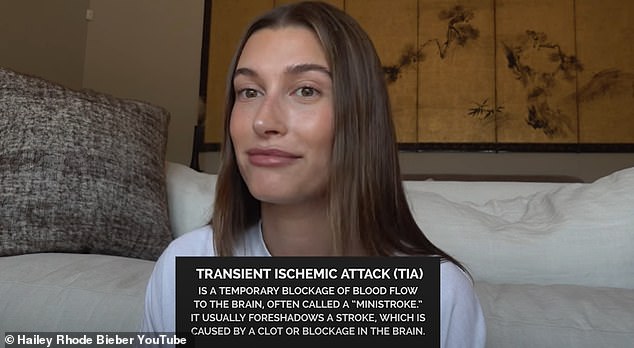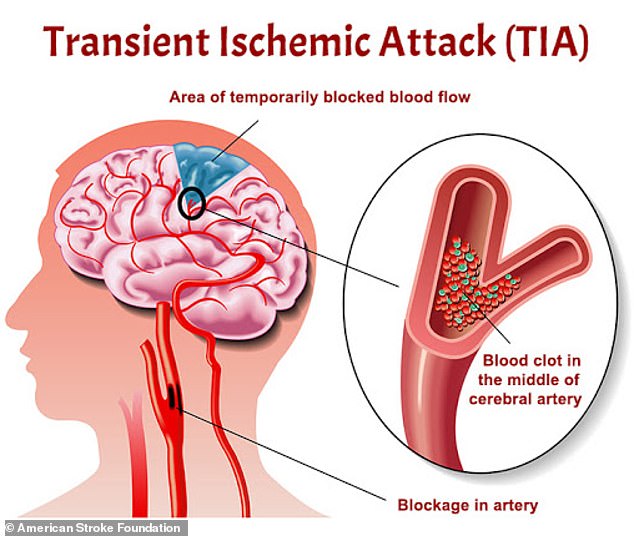Why are strokes more common in young people? While Snoop Dogg’s 24-year-old daughter is recovering from one
After Snoop Dogg’s young daughter suffered a stroke, many are wondering how someone as young as 24 could suffer from a “geriatric disease.”
Strokes normally affect adults in their 70s, but have been rising faster for decades among younger adults (those 18 to 45) than among those in any other age group. In some hospitals, cases have nearly doubled in just a few years.
Doctors say more unhealthy lifestyles and rising rates of obesity may be behind this shift – with obesity increasing the risk of weak arteries that can cause blood clots.
But other factors, such as overconsumption of alcohol and the higher rates of smoking, vaping and even marijuana use among young adults, could also be to blame.
Cori Broadus, who lives in Los Angeles, revealed she “cried so much” when doctors said she had suffered a stroke. They’re not sure what causes it, but she does have the autoimmune disease lupus – where the body attacks its own cells – which can increase the risk.
Cori Broadus, 24, is pictured above with her father Snoop Dogg. She suffered a stroke at a young age, raising concerns about the possible cause of the condition
Data from the American Heart Association shows that stroke rates in the U.S. increased by 43 percent among youth ages 18 to 44 between 2004 and 2018.
Cori is the latest high-profile young celebrity to suffer a stroke after Hailey Beiber also suffered from stroke-like symptoms and a ‘minor’ blockage in her brain in 2022 at the age of just 25.
And the same year, Real Housewives of Atlanta alum Nene Leakes revealed that her 23-year-old son, Brentt Leakes, was also a stroke survivor.
Ms Broadus revealed her diagnosis online, saying she ‘burst into tears’ when doctors told her what had happened.
“I’m only 24, what have I done in my past to deserve all this,” she said.
The most common form of stroke – called ischemic stroke, which accounts for about 60 percent of cases among young people – is caused by a blockage or clot that restricts blood flow in the brain, leading to cells being deprived of essential oxygen and nutrients and begin to bleed. die.
The other major type of stroke, called hemorrhagic strokes, is when a blood vessel in the brain bursts and its contents begin to leak into the organ.
“We used to see stroke in younger people, especially in people with a genetic predisposition, such as a blood clotting disorder,” said Melinda Tafoya, a stroke researcher at the hospital.
“But now we’re seeing how quickly poor lifestyle choices can affect the body and overall risk of stroke in younger adults.”

The hospital where Ms. Bieber was sent after experiencing numbness in her arm and fingers confirmed that she had suffered a Transient Ischemic Attack (TIA), commonly known as a mini-stroke.

A mini-stroke, medically known as a transient ischemic attack, occurs when a blockage occurs in a person’s cerebral artery, preventing blood from flowing to the brain. It has the same symptoms as a regular stroke, but resolves on its own within 24 hours
Among older adults (those 75 years and older), the rate of complications dropped by two percent, although the overall rate is still much higher than among those in the younger age groups.
Doctors at UC Health add that the share of their patients aged 18 to 45 admitted with a stroke has almost doubled – from five percent in 2020 to more than nine percent in 2023.
Doctors have offered several theories about what could be behind this increase, including pointing to rising levels of obesity among young people.
Statistics show that as many as two in five adults aged 20 to 39 are now obese, while among those aged 40 to 59 the rate has risen to 44 percent – almost half.
Obesity can weaken blood vessels, increasing their risk of damage that leads to the formation of blood clots, which can cause strokes.
Dr. Tafoya, who suggests obesity increases the risk of stroke among young people, said: ‘We have certainly seen an increase in poor lifestyle choices in younger people, such as unhealthy eating, less exercise and exercise and being overweight.’
The condition also increases the risk of other complications, such as high blood pressure and diabetes, which are also known to increase the risk of stroke.
Additionally, studies suggest that smoking marijuana could also increase the risk of stroke in an article published last September that found those who smoked weed had a chance 60 percent higher risk of serious medical problems, including heart attacks and strokes.
The exact reason for this is not clear, but Canadian researchers have suggested that it could be due to cannabis activating the endocannabinoid system – a network of receptors in the body that respond to compounds in cannabis.
Activating the network causes an increased heart rate and constricted blood vessels, increasing the risk of heart attacks and strokes.
Some consumers also consume marijuana by smoking it as a joint, which is also known to increase the risk of stroke by causing inflammation that can damage the lining of blood vessels.
Marijuana use among American youth has soared amid a wave of legalizations, with 29 percent of young people between the ages of 19 and 30 now using the drug – up from 21 percent in 2016 and 17 percent in 2011.
Dr. Tafoya added: ‘Activities such as using alcohol, drugs and smoking can also increase the risk of stroke, and these activities often start at a younger age.’
Alcohol can also increase the risk of clots by interfering with factors that form clots in the blood, causing more to form. Smoking is a known major risk factor for stroke.
Some studies are now also beginning to link vaping – popular among young adults – to the same condition, as they also vape.
Some experts have also suggested that Covid may be behind the increase in the number of young people, pointing out that the virus can cause thickening of the blood, increasing the risk of clots forming that could cause the complications.
Mrs Broadus has since been released from hospital and said online the day before: ‘God is working overtime, you hear me! My kidneys were doing terribly. The doctors came this morning and said it’s going so much better.’
She added, “Again, I’m human and I go through things like everyone else, that’s why I’m so open about my life because I know I feel alone.
“But we’re never alone, there’s always someone going through the damn same thing.”
It’s not clear if she uses pot, but in November last year her father, a longtime marijuana enthusiast, revealed he was quitting the drug.
Snoop Dogg – whose real name is Calvin Cordozar Broadus, Jr. is – revealed that his daughter was ‘doing a little better’ when he was asked about her on the red carpet for the launch of The Underdogg’s film earlier last week.
Requested by People On whether it had helped him put his life into perspective, the 52-year-old said: ‘Yes, yes. Something like that.’
Patients who suffer a stroke may subsequently experience mild symptoms that resolve quickly or serious complications that leave them disabled.
Older adults are at much greater risk because they are more likely to develop blood clots and plaques on the walls of their blood vessels, which can become loose and cause a stroke.
